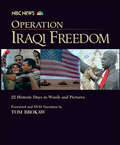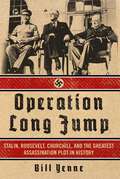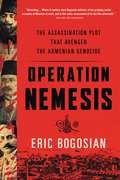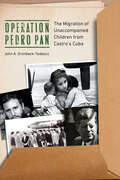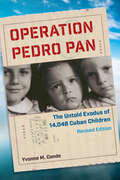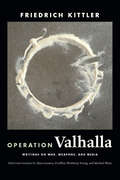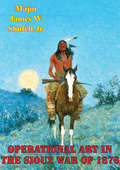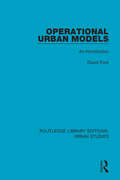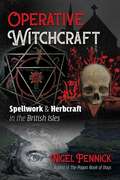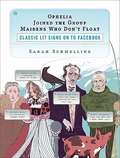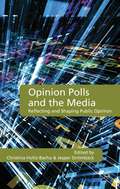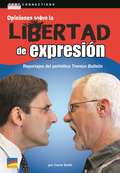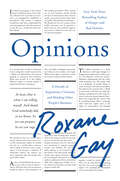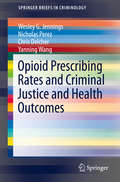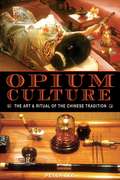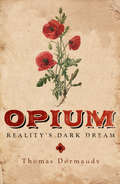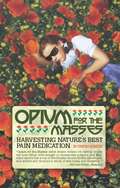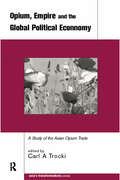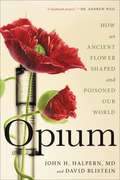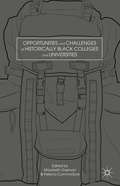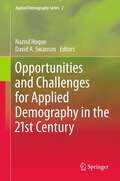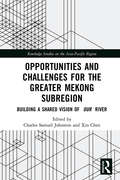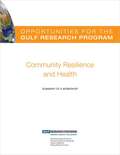- Table View
- List View
Operation Iraqi Freedom: The Inside Story
by Marc Kusnetz; William M. Arkin; General Montgomery Meigs, retired; and Neal ShapiroGo inside the historic Iraq War coverage of NBC News with this in-depth, illustrated history—with a foreword by Tom Brokaw. Operation Iraqi Freedom marked a new era in television war coverage. On-the-spot reporting by journalists, photographers, and cameramen captured combat in ways that are nothing less than historic. Viewers were transported to the front lines and embedded among the troops. Among all network and cable news organizations covering the Iraqi war, NBC news was the acknowledged leader. This book, written and produced by NBC News, presents a chronological narrative of reporting from the field supplemented by interviews and anchored broadcasts from Qatar, Kuwait, and the United States. Thousands of hours of images and words have been molded into a concise, eloquent summary of the historic events of the conflict. The book also includes an introduction by an NBC military expert, and a special dedication to fallen colleague David Bloom.
Operation Long Jump: Stalin, Roosevelt, Churchill, and the Greatest Assassination Plot in History
by Bill YenneIn the middle of World War II, Nazi military intelligence discovered a seemingly easy way to win the war for Adolf Hitler. The three heads of the Allied forces--Franklin Roosevelt, Winston Churchill, and Josef Stalin--were planning to meet in Tehran in October, 1943. Under Hitler's personal direction, the Nazis launched "Operation Long Jump,” an intricate plan to track the Allied leaders in Tehran and assassinate all three men at the same time. "I suppose it would make a pretty good haul if they could get all three of us,” Roosevelt later said. Historian Bill Yenne retells the incredible, globe-spanning story of the most ambitious assassination plot ever thwarted in Operation Long Jump.
Operation Nemesis: The Assassination Plot that Avenged the Armenian Genocide
by Eric BogosianA masterful account of the assassins who hunted down the perpetrators of the Armenian GenocideIn 1921, a tightly knit band of killers set out to avenge the deaths of almost one million victims of the Armenian Genocide. They were a humble bunch: an accountant, a life insurance salesman, a newspaper editor, an engineering student, and a diplomat. Together they formed one of the most effective assassination squads in history. They named their operation Nemesis, after the Greek goddess of retribution. The assassins were survivors, men defined by the massive tragedy that had devastated their people. With operatives on three continents, the Nemesis team killed six major Turkish leaders in Berlin, Constantinople, Tiflis, and Rome, only to disband and suddenly disappear. The story of this secret operation has never been fully told, until now. Eric Bogosian goes beyond simply telling the story of this cadre of Armenian assassins by setting the killings in the context of Ottoman and Armenian history, as well as showing in vivid color the era's history, rife with political fighting and massacres. Casting fresh light on one of the great crimes of the twentieth century and one of history's most remarkable acts of vengeance, Bogosian draws upon years of research and newly uncovered evidence. Operation Nemesis is the result--both a riveting read and a profound examination of evil, revenge, and the costs of violence.
Operation Pedro Pan: The Migration of Unaccompanied Children from Castro's Cuba
by Dr. John A. Gronbeck-TedescoAt the outset the proposal seemed modest: transfer two hundred unaccompanied Cuban children to Miami to save them from communism. The time apart from their parents would be short, only until Fidel Castro fell from power by the result of U.S. force, Cuban counterrevolutionary tactics, or a combination of both. Families would be reunited in a matter of months. A plan was hatched, and it worked—until it ballooned into something so unwieldy that within two years the modest proposal erupted into what at the time was the largest migration of unaccompanied minors to the United States.Operation Pedro Pan explores the undertaking sponsored by the Miami Catholic Diocese, federal and state offices, child welfare agencies, and anti-Castro Cubans to bring more than fourteen thousand unaccompanied children to the United States during the Cold War. Operation Pedro Pan was the colloquial name for the Unaccompanied Cuban Children&’s Program, which began under government largesse in February 1961. Children without immediate family support in the United States—some 8,300 minors—received group and foster care through the Catholic Welfare Bureau and other religious, governmental, and nongovernmental organizations as young people were dispersed throughout the country. Using personal interviews and newly unearthed information, Operation Pedro Pan provides a deeper understanding of how and why the program was devised. John A. Gronbeck-Tedesco demonstrates how the seemingly mundane conditions of everyday life can suddenly uproot civilians from their routines of work, church, and school and thrust them into historical prominence. The stories told by Pedro Pans are filled with horror and resilience and contribute to a refugee memory that still shapes Cuban American politics and identity today.
Operation Pedro Pan: The Untold Exodus of 14,048 Cuban Children, Revised Edition (New World Diasporas Ser.)
by Yvonne M. CondePoignant stories from one of the world’s largest political exoduses of children Praise for the first edition: “Compelling reading.”—New Republic “A collection of tearful testimonies woven with a tale of the event that unfolded in Cuba and led desperate parents to make the heart-wrenching decision to send their children along to a foreign country.”—Miami Herald “[Conde] does an impressive job of reporting dozens of personal stories and fascinating vignettes. . . . A compilation of tales, some moving, many astonishing.”—Chicago Tribune “A well-researched history of Operation Pedro Pan, a portrait of early revolutionary Cuba and a compendium of testimony from the now-grown children.”—Publishers Weekly “The book’s primary value lies in the individual stories, from tearful departure and arrival in Miami to temporary shelters and placement in homes or, in some cases, in orphanages; to learning a new language and adjusting and, in many cases, assimilating; to reunions with parents, adolescence in the ’60s and ’70s, and adulthood.”—Booklist “Conde does an excellent job of narrating the essential outline of the history of Operation Pedro Pan, and an equally superb job of analyzing the circumstances that created this exodus, from the viewpoint of those who felt compelled to create it and keep it going. . . . Operation Pedro Pan is . . . as much a primary source as it is a work of history, as much a window onto a mentality as it is a guide to events, names, and institutions.”—Carlos M. N. Eire, Hispanic American Historical Review “Fascinating is the least one can say about this book. It’s the story of thousands of Cuban children who wouldn’t grow up under communism and were sent by their parents to the never-never land of America. Some of them lived happily ever after because this version of Peter Pan is a tragedy with a happy ending sometimes. Fidel Castro, by the way, plays a very credible Captain Hook.”—Guillermo Cabrera Infante, Cervantes Prize‒winning novelist On August 11, 1961, at the age of ten, Yvonne Conde left Cuba in one of the world’s largest political exoduses of children in history—Operation Pedro Pan. Between 1960 and 1962 over 14,000 children were sent out of Cuba alone by desperate parents who feared for their children’s future under Castro. Unlike Peter Pan, however, these children continued to grow up even while separated from their families. As the children arrived in temporary camps in Miami, volunteers such as Father Bryan O. Walsh helped them find new homes across the country. Conde tracked down hundreds of these children to tell their diverse stories—their uplifting, poignant, and somet
Operation Valhalla: Writings on War, Weapons, and Media (a Cultural Politics book)
by Friedrich KittlerOperation Valhalla collects eighteen texts by German media theorist Friedrich Kittler on the close connections between war and media technology. In these essays, public lectures, interviews, literary analyses, and autobiographical musings, Kittler outlines how war has been a central driver of media's evolution, from Prussia's wars against Napoleon to the so-called War on Terror. Covering an eclectic array of topics, he charts the intertwined military and theatrical histories of the searchlight and the stage lamp, traces the microprocessor's genealogy back to the tank, shows how rapid-fire guns brought about new standards for optics and acoustics, and reads Thomas Pynchon's Gravity's Rainbow to upset established claims about the relationship between war, technology, and history in the twentieth century. Throughout, Operation Valhalla foregrounds the outsize role of war in media history as well as Kittler's importance as a daring and original thinker.
Operational Art In The Sioux War Of 1876
by Major James W. Shufelt Jr.This monograph discusses the role of operational art in the Sioux War of 1876, the U.S. Army's largest campaign between the Civil War and the Spanish-American War. This campaign, often overlooked in the historical study of operational art, demonstrates the successful application of operational art in a non-traditional campaign: the U.S. Army's defeat of the Northern Sioux Indians and their allies. This campaign also demonstrates how operational art can lead to operational victory, despite repeated tactical failures.The monograph first defines operational art, based on emerging U.S. Army doctrine, and then reviews its role in three campaigns that served as models for the Army's operations in the Sioux War of 1876: Grant's 1864-1865 campaign to defeat the Confederacy, the Southern Plains War of 1868-1869, and the Red River War of 1874-1875. The plans and execution of the Sioux War of 1876 are then reviewed and analyzed utilizing the definition of operational art and modem concepts for operational planning. The causes of failure in the 1876 campaign are then analyzed, based on Cohen and Gooch's methodology for analysis of military failure, followed by explanation of the campaign's ultimate success.The monograph concludes that the Frontier Army's success in this campaign demonstrates successful application of operational art, despite many errors in planning and execution committed by General Sheridan and his subordinates. Additional lessons from this campaign include the danger of blindly applying previously successful models for operations, the preeminent role of the operational commander, and the validity of operational art in campaigns against unconventional foes.
Operational Urban Models: An Introduction (Routledge Library Editions: Urban Studies)
by David FootFirst published in 1981. Urban modelling techniques are an established tool in assessing the possible repercussions of major changes in land use. This book is an introductory guide to the various models that have been developed and to how they can be applied in planning practice, particularly with relation to land use activities such as residential, industrial and retail development, and changes in the transport network. The author has provided a coherent and reliable introductory text which will be welcomed by students and teachers in search of a guide to current methods in the field of urban modelling.
Operative Witchcraft: Spellwork and Herbcraft in the British Isles
by Nigel PennickA comprehensive look at the history and practices of rural English witchcraft • Explores witch’s familiars and fetches, animal magic, and the forms of witchcraft practiced by rural tradespeople, such as blacksmiths, herbalists, and artisans • Offers practical insight into spells, charms, folk incantations, herbal medicine practices, amulets, sigils, and tools of the craft • Details the evolution of public perception of witchcraft throughout England’s history, including the laws against witchcraft in place until the 1950s and witchcraft’s contentious relationship with the Christian church In this practical guide, Nigel Pennick takes the reader on a journey through the practice of operative witchcraft in the British Isles from the Middle Ages and the Elizabethan era to the decriminalization of witchcraft in the 1950s and its practice today. Highlighting uniquely English traditions, Pennick explores fetches and witch’s familiars, animal magic, and the forms of witchcraft practiced by rural tradespeople, such as blacksmiths, herbalists, and artisans, to enhance their professional work and compel others to do their bidding, both man and beast. He provides actual spells, charms, and folk incantations, along with details about the magical use of a variety of herbs, including nightshades, the creation of amulets and sigils, protection against the Evil Eye, and the use of aromatic oils. Pennick explains the best times of day for different types of magic, how to identify places of power, and the use of the paraphernalia of operative witchcraft, such as the broom, the witches’ dial, and pins, nails and thorns. He explores the belief in three different types of witches: white witches, who offer help and healing for a fee; black witches, who harm others; and gray witches, who practice both white and black magic. Examining witchcraft’s contentious relationship with the Christian church, he investigates the persecution of witches throughout the UK and the British West Indies up until the mid-20th century. He offers a look into the changing public perceptions of witchcraft and the treatment of its followers as well as revealing how English churchmen would offer magical solutions to the perceived threat of black witchcraft. Painting an in-depth picture of English witchcraft, including how it relates to and differs from modern Wicca, Pennick reveals the foundation from which modern witchcraft arose. He shows how this context is necessary to effectively use these ancient skills and techniques and how the evolution of witchcraft will continue harmonizing the old ways with the new.
Ophelia Joined the Group Maidens Who Don't Float
by Sarah SchmellingRead Sarah Schmelling's posts on the Penguin Blog. When humorist Sarah Schmelling transformed Hamlet into a Facebook news feed on McSweeney’s, it launched the next big humor trend—Facebook lit. In this world, the king “pokes” the queen, Hamlet becomes a fan of daggers, and Ophelia renounces her interest in moody princes. Now, what began as an internet phenomenon is a book. Ophelia Joined The Group Maidens Who Don’t Float: Classic Lit Signs on to Facebook is a clever spoof of the most-trafficked social networking website and a playful game of literary who’s who. The book brings more than fifty authors and stories from classic literature back to life and online, and it is sure to have book lovers and Facebook addicts alike twittering with joy. From The Odyssey to The Adventures of Huckleberry Finn, Pride and Prejudice to Lolita, Schmelling brings the conventions of social networking—profile pages, status updates, news feeds, games and quizzes—to some of literature’s most well-known works, authors and characters. What would Edgar Allan Poe, Jane Austen or James Joyce post on their “walls”? What would Gulliver, Miss Havisham or Captain Ahab say in a status update? After William Shakespeare welcomes all of these players into his network, mayhem quickly ensues: Elizabeth Bennet throws a sheep at Mr. Darcy Hamlet posts an event: A Play That’s Totally Fictional and In No Way About My Family Jane Eyre listens to “Hard Knock Life” on repeat The Lord of the Flies boys form a reunion group Ernest Hemingway questions the validity of the “Are you a real man?” quiz Mark Twain infiltrates Oscar Wilde’s profile page and challenges him to a “quip off” Oedipus works on his family tree Following everyone from Frankenstein’s Monster to King Lear’s Fool, Charles Dickens to Virginia Woolf, Ophelia Joined The Group Maidens Who Don’t Float is a loving spoof of our literary favorites, and a hilarious collection for a twenty-first century generation of readers. Long live the Classics: 2. 0! .
Opinion Polls and the Media
by Christina Holtz-Bacha Jesper Str�mb�ckOpinion Polls and the Media provides the most comprehensive analysis to date on the relationship between the media, opinion polls, and public opinion. Looking at the extent to which the media, through their use of opinion polls, both reflect and shape public opinion, it brings together a team of leading scholars and analyzes theoretical and methodological approaches to the media and their use of opinion polls. The contributors explore how the media use opinion polls in a range of countries across the world, and analyze the effects and uses of opinion polls by the public as well as political actors.
Opiniones sobre la libertad de expresión: Reportajes del periódico Trenton Bulletin (Text Connections)
by Carrie SmithNIMAC-sourced textbook
Opinions About Odysseus: A Greek Hero
by Cynthia Swain Jeffrey B. Fuerst Jose RamosRead about a hero from Greek myths, Odysseus, and some of his adventures. Then read and evaluate opinion pieces about his use of violence to combat various monsters from Greek myths.
Opinions: A Decade of Arguments, Criticism, and Minding Other People's Business
by Roxane GayFrom beloved and bestselling author Roxane Gay, “a strikingly fresh cultural critic” (Washington Post) comes an exhilarating collection of her essays on culture, politics, and everything in between. Since the publication of the groundbreaking Bad Feminist and Hunger, Roxane Gay has continued to tackle big issues embroiling society—state-sponsored violence and mass shootings, women’s rights post-Dobbs, online disinformation, and the limits of empathy—alongside more individually personalized matters: can I tell my co-worker her perfume makes me sneeze? Is it acceptable to schedule a daily 8 am meeting? In her role as a New York Times opinion section contributor and the publication’s “Work Friend” columnist, she reaches millions of readers with her wise voice and sharp insights.Opinions is a collection of Roxane Gay’s best nonfiction pieces from the past ten years. Covering a wide range of topics—politics, feminism, the culture wars, civil rights, and much more—with an all-new introduction in which she reflects on the past decade in America, this sharp, thought-provoking anthology will delight Roxane Gay’s devotees and draw new readers to this inimitable talent.
Opioid Prescribing Rates and Criminal Justice and Health Outcomes (SpringerBriefs in Criminology)
by Wesley G. Jennings Chris Delcher Nicholas Perez Yanning WangThis brief uses California’s CURES (Controlled Substance Utilization Review and Evaluation System) 2.0 data to analyze county-level opioid prescribing rates in California from 2012 to 2017 from multiple perspectives. The book summarizes California’s county-level opioid prescribing trends, examines potential correlates of opioid prescribing rates, and assesses the association of opioid prescribing on both criminal justice and public health outcomes. Finally, the authors discuss their principal findings and the implications for policy and practice, including the significant and lasting consequences of the opioid crisis on the criminal justice system and the importance of a multi-disciplinary approach to effectively address the crisis.
Opioid Reckoning: Love, Loss, and Redemption in the Rehab State
by Amy C. SullivanExamines the complexity and the humanity of the opioid epidemic America&’s opioid epidemic continues to ravage families and communities, despite intense media coverage, federal legislation, criminal prosecutions, and harm reduction efforts to prevent overdose deaths. More than 450,000 Americans have died from opioid overdoses since the late 1990s. In Opioid Reckoning, Amy C. Sullivan explores the complexity of the crisis through firsthand accounts of people grappling with the reverberating effects of stigma, treatment, and recovery. Nearly everyone in the United States has been touched in some way by the opioid epidemic, including the author and her family. Sullivan uses her own story as a launching point to learn how the opioid epidemic challenged longstanding recovery protocols in Minnesota, a state internationally recognized for pioneering addiction treatment. By centering the voices of many people who have experienced opioid use, treatment, recovery, and loss, Sullivan exposes the devastating effects of a one-size-fits-all approach toward treatment of opioid dependency. Taking a clear-eyed, nonjudgmental perspective of every aspect of these issues—drug use, parenting, harm reduction, medication, abstinence, and stigma—Opioid Reckoning questions current treatment models, healthcare inequities, and the criminal justice system. Sullivan also imagines a future where anyone suffering an opioid-use disorder has access to the individualized care, without judgment, available to those with other health problems. Opioid Reckoning presents a captivating look at how the state that invented &“rehab&” addresses the challenges of the opioid epidemic and its overdose deaths while also taking readers into the intimate lives of families, medical and social work professionals, grassroots activists, and many others impacted by the crisis who contribute their insights and potential solutions. In sharing these stories and chronicling their lessons, Sullivan offers a path forward that cultivates empathy, love, and hope for anyone affected by chaotic drug use and its harms.
Opium Culture: The Art and Ritual of the Chinese Tradition
by Peter LeeA detailed study of the history and usage of opium• Explores the use of opium as a major healing herb and a popular relaxant• Details the opium practices adhered to in the Chinese tradition• Includes information on the suppression of opium by the modern pharmaceutical industryOpium. The very sound of the word conjures images of secret rooms in exotic lands, where languid smokers lounge dreamily in a blue haze of fragrant poppy smoke, inhaling from long bamboo pipes held over the ruby flame of the jade lamp. Yet today very little accurate information is available regarding a substance that for 300 years was central to the lives of millions of people throughout the world.In Opium Culture Peter Lee presents a fascinating narrative that covers every aspect of the art and craft of opium use. Starting with a concise account of opium’s long and colorful history and the story of how it came to be smoked for pleasure in China, Lee offers detailed descriptions of the growing and harvesting process; the exotic inventory of tools and paraphernalia required to smoke opium as the Chinese did; its transition from a major healing herb to a narcotic that has been suppressed by the modern pharmaceutical industry; its connections to the I Ching, Taoism, and Chinese medicine; and the art, culture, philosophy, pharmacology, and psychology of this longstanding Asian custom. Highlighted throughout with interesting quotes from literary and artistic figures who were opium smokers, such as Jean Cocteau, Pablo Picasso, Herman Melville, and Samuel Taylor Coleridge, the text is studded with gems of long forgotten opium arcana and dispels many of the persistent myths about opium and its users.
Opium Reality's Dark Dream
by Thomas DormandyOpium and its derivatives morphine and heroin have destroyed, corrupted, and killed individuals, families, communities, and even whole nations. And yet, for most of its long history, opium has also been humanity's most effective means of alleviating physical and mental pain. This extraordinary book encompasses the entire history of the world's most fascinating drug, from the first evidence of poppy cultivation by stone-age man to the present-day opium trade in Afghanistan. Dr. Thomas Dormandy tells the story with verve and insight, uncovering the strange power of opiates to motivate major conflicts yet also inspire great art and medical breakthroughs, to trigger the rise of global criminal networks yet also revolutionize attitudes toward well-being. Opium: Reality's Dark Dreamtraverses the globe and the centuries, exploring opium's role in colonialism, the Chinese Opium Wars, laudanum-inspired sublime Romantic poetry, American "Yellow Peril" fears, the rise of the Mafia and the black market, 1960s counterculture, and more. Dr. Dormandy also recounts exotic or sad stories of individual addiction. Throughout the book the author emphasizes opium's complex, valuable relationship with developments in medicine, health, and disease, highlighting the perplexing dual nature of the drug as both the cause and relief of great suffering in widely diverse civilizations.
Opium for the Masses
by Jim Hogshire"Contrary to general belief, there is no federal law against growing P. somniferum."--Martha Stewart Living"Regarded as 'God's own medicine,' preparations of opium were as common in the Victorian medicine cabinet as aspirin is in ours. As late as 1915, pamphlets issued by the U.S. Department of Agriculture were still mentioning opium poppies as a good cash crop for northern farmers. Well into this century, Russian, Greek, and Arab immigrants in America have used poppy-head tea as a mild sedative and a remedy for headaches, muscle pain, cough, and diarrhea. During the Civil War, gardeners in the South were encouraged to plant opium for the war effort, in order to ensure a supply of painkillers for the Confederate Army. What Hogshire has done is to excavate this vernacular knowledge and then publish it to the world--in how-to form, with recipes."-- Michael PollanFirst published fifteen years ago, Opium for the Masses instantly became a national phenomenon. Michael Pollan wrote a lengthy feature ("Opium, made easy") about Jim Hogshire in Harper's Magazine, amazed that the common plant, P. somniferum, or opium poppies, which grows wild in many states and is available at crafts and hobby stores and nurseries, could also be made into a drinkable tea that acts in a way similar to codeine or Vicodin.With Opium for the Masses as their guide, Americans can learn how to supplement their own medicine chest with natural and legal pain medicine, without costly and difficult trips to the doctor and pharmacy.
Opium, Empire and the Global Political Economy: A Study of the Asian Opium Trade 1750-1950 (Asia's Transformations)
by Carl TrockiDrug epidemics are clearly not just a peculiar feature of modern life; the opium trade in the nineteenth century tells us a great deal about Asian herion traffic today. In an age when we are increasingly aware of large scale drug use, this book takes a long look at the history of our relationship with mind-altering substances. Engagingly written, with lay readers as much as specialists in mind, this book will be fascinating reading for historians, social scientists, as well as those involved in Asian studies, or economic history.
Opium: How an Ancient Flower Shaped and Poisoned Our World
by David Blistein John H. Halpern"A landmark project." -- Dr. Andrew Weil"Engrossing and highly readable." -- Sam Quinones"An astonishing journey through time and space." -- Julie Holland, MD"The most important, provocative, and challenging book I've read in a long time." -- Laurence BergreenFrom a psychiatrist on the frontlines of addiction medicine and an expert on the history of drug use, comes the "authoritative, engaging, and accessible" (Booklist) history of the flower that helped to build -- and now threatens -- modern society.Opioid addiction is fast becoming the most deadly crisis in American history. In 2018, it claimed nearly fifty thousand lives -- more than gunshots and car crashes combined, and almost as many Americans as were killed in the entire Vietnam War. But even as the overdose crisis ravages our nation -- straining our prison system, dividing families, and defying virtually every legislative solution to treat it -- few understand how it came to be. Opium tells the extraordinary and at times harrowing tale of how we arrived at today's crisis, "mak[ing] timely and startling connections among painkillers, politics, finance, and society" (Laurence Bergreen). The story begins with the discovery of poppy artifacts in ancient Mesopotamia, and goes on to explore how Greek physicians and obscure chemists discovered opium's effects and refined its power, how colonial empires marketed it around the world, and eventually how international drug companies developed a range of powerful synthetic opioids that led to an epidemic of addiction. Throughout, Dr. John Halpern and David Blistein reveal the fascinating role that opium has played in building our modern world, from trade networks to medical protocols to drug enforcement policies. Most importantly, they disentangle how crucial misjudgments, patterns of greed, and racial stereotypes served to transform one of nature's most effective painkillers into a source of unspeakable pain -- and how, using the insights of history, state-of-the-art science, and a compassionate approach to the illness of addiction, we can overcome today's overdose epidemic. This urgent and masterfully woven narrative tells an epic story of how one beautiful flower became the fascination of leaders, tycoons, and nations through the centuries and in their hands exposed the fragility of our civilization.
Opportunities And Challenges At Historically Black Colleges And Universities
by Marybeth Gasman Felecia CommodoreIn this edited collection, the authors grapple with both the strengths and challenges that HBCUs face as the nation's demographics change, from their place in American society and growing diversity on HBCU campuses to class and elitism issues to study abroad and honors programs.
Opportunities and Challenges for Applied Demography in the 21st Century
by David A. Swanson Nazrul HoqueApplied demography continues its rapid pace of evolution in concert with the emerging trends of the 21st century. One significant area of change is the extension of applied demography beyond the United States; this book includes material dealing with applied demography in Australia, Canada, Estonia, and Mexico. Opportunities and Challenges for Applied Demography in the 21st Century presents a score of selected papers from the second post-2000 national conference on Applied Demography, held in San Antonio, Texas, in January, 2010, under the sponsorship of the Institute for Demographic and Socioeconomic Research at The University of Texas at San Antonio. Coverage includes the assembly of data by government agencies, with a focus on issues facing the United States; demographic issues associated with globalization; business demography and health demography, as well as a section examining methodological advances in the areas of estimation and projection.
Opportunities and Challenges for the Greater Mekong Subregion: Building a Shared Vision of Our River (Routledge Studies on the Asia-Pacific Region)
The Mekong River is a vital and valuable resource, with huge development potential for the six states through which it flows. Given the significant asymmetry of power between those states, however, there is a real risk that some might utilise it to the detriment of others. Without a sense of regional belonging, it is difficult to imagine that these states and their constituent communities will take regional imperatives to heart, participate in joint regulatory frameworks, or adopt behaviours for upstream-downstream and lateral cooperation over the appropriation and use of their shared resources. How effectively has closer interdependence of the Mekong countries accommodated the development of a political-social-cultural space conducive to the growth of a regional "we-ness" among not only political elites, but also the general public? The contributors to this volume approach this question from a range of directions, including the impacts of tourism, regional development programmes, the Mekong Power Grid, and Sino-US rivalry. This edited volume presents valuable insights for scholars of international relations, Asian studies, development studies, environment studies, policy studies, and human geography.
Opportunities for the Gulf Research Program: Summary of a Workshop
by Leighanne OlsenThere are many connections between human communities and their surrounding environments that influence community resilience and health in the Gulf of Mexico. The impacts of the Deepwater Horizon oil spill on Gulf communities and ecosystems - coupled with the region's preexisting health challenges and environmental stressors - illustrate the need to better understand these connections. In the future, natural and man-made disasters, climate change impacts, and other environmental stressors will present complex challenges to the physical, mental, and social well-being of communities in the Gulf. Understanding the interrelationships among health, ecological, and economic impacts of disasters and other environmental stressors will be crucial to addressing these challenges. Opportunities for the Gulf Research Program: Community Resilience and Health summarizes a Gulf Research Program workshop held on September 22-23, 2014, in New Orleans, Louisiana. The workshop examined opportunities to improve the health, well-being, and resilience of communities in the Gulf region through discussions with about 50 participants with diverse expertise and experience. These discussions identified perceived needs, challenges, and opportunities that align with the Gulf Research Program's mission and goals - particularly its goal to improve understanding of the connections between human health and the environment to support the development of health and resilient Gulf communities. This workshop is expected to lead to the development of additional Program activities and opportunities for the research community.
